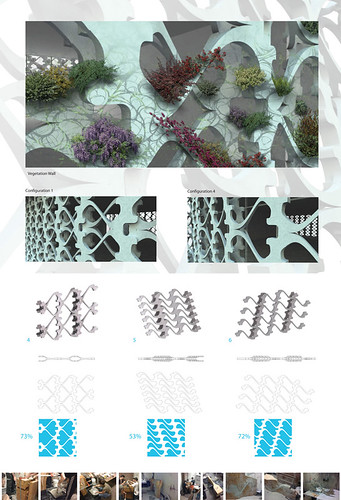
For my final semester I placed music videos on hold and devoted my time to physically testing digital models. Dora Kelle, Adam Mercier and I worked together to develop the Brise Block. Our Rhino model was deliberately kept simple so that we could focus on the fabrication process of the block. Of the fifteen weeks that we spent working on the project, only three or four days went into the design process. We spent the next two months testing concrete and making adjustments based on our failures. In the end we were able to complete 14 blocks and make a mock up for the end of the year show at Columbia. We also entered the 2007-08 ACSA/PCA CONCRETE THINKING FOR A SUSTAINABLE WORLD, International Student Design Competition – Building Element - Category II as representatives of Columbia and received third place! This has led to our next project which I mentioned in my previous post, called Amphorae. You can follow our progress on our blog here: http://amphorae.wordpress.com/
We will be working hard over the next two months to finish our new vision for a building block.

Here was our description:
In March our studio was lucky enough to take a trip to Brazil to research modern
architecture. Our focus was specifically in Brasilia where were analyzing the buildings of the pilot plan. The most significant thing we noticed not only in Brasilia, but throughout our trip to South America, was how ecologically sensitive the architecture was. Buildings such as the Hospital Sarah Kubitschek de Brasília were incredibly inspirational. The hospital was a constant interplay between the interior and exterior spaces and concrete was used to blur these boundaries. This was exhibited through perforated walls, brie soleil, covered patios and numerous indoor gardens. The Brie Block is the material realization of the notion of bringing the outside in. The module itself represents a series of countless iterations and adjustments to make a sustainable material system which is aesthetically dynamic, structurally sound and ecologically sensitive.
The Brie Block is a precast concrete element to be implemented as a brie soleil. While the brie soleil is a sustainable element because of its ability to control environmental conditions, the Brie Block is a single unit that can adapt to and control a wider range of conditions due to its reconfigurability. Six different configurations are possible, ranging from 33 – 73% porosity. Configurations can be recombined with one another to create a dynamic brie soleil. The blocks which are to be grouted in place once aligned via pins are able to aggregate in positions which mirror, interlock, flip as well as extend in two directions in plan. The intelligence built into the individual unit itself is what allows the dynamic walls to be produced with so many different options. Adapting to very specific site conditions the precast element is itself very specific but also quite generic. The reconfigurability of the block enables design changes through the life of the project not at just initiation of the design considering the long term issues which may arise as well. Achieving a versatile building system is many times very difficult considering the need to provide formwork for concrete. Complex forms many times need special formwork and if a variety of elements are desired much fabrication and detailing of many multiple custom formworks need to be designed. While CNC milling has allowed architects to create different modules at the same rate as mass produced modules, it also creates exponential amounts of waste. Placing all of the effort into the geometry itself allows a single mold typology to be 3 axis CNC milled which can be reused countless times allowing for minimal startup costs and waste of material. In the end we were able to generate a fully functional reusable mold and we’ve been able to cast dozens of bricks from the shell. The one distinct mold would create the complexity of multiple elements while only being a singular typology. The Brie Block relies very heavily on the properties of concrete to make its achievements. No other material could be cast with such great strength and at such a low cost. Its ability to be cast is also extremely important given concretes ability to take almost any form based on its formwork. Each block weighs only 36 pounds and spans a total of 42 inches (32 inch bond) with a height of 18 inches. The material economy of the block enables construction to be more environmentally friendly and easily installed. The blocks can easily be hand lifted and installed with only alignment pins and grout. Using polypropylene / polyethylene blended synthetic macro-fibers as reinforcement allowed replacement of structural steel and economized cross-sectional material. Reducing the amount of cover needed for steel reinforcement and producing a multidirectional system of tensional reinforcement allows the block to conform to minimal material and maximal formal potential. Saving material means less overall cost and a more sustainable way of building. After several iterations, the block can be fabricated with sections as thin as 1.5 inches at a material cost of only $5.



No Comments
Block this user
Are you sure you want to block this user and hide all related comments throughout the site?
Archinect
This is your first comment on Archinect. Your comment will be visible once approved.